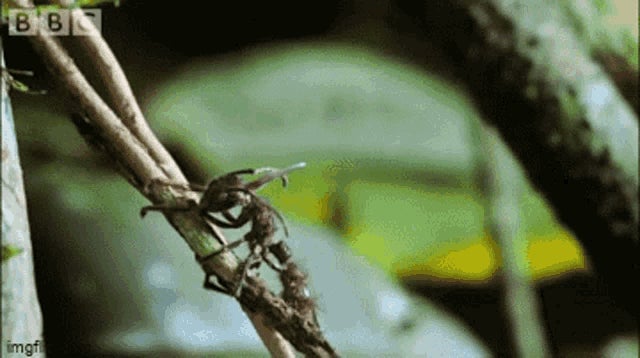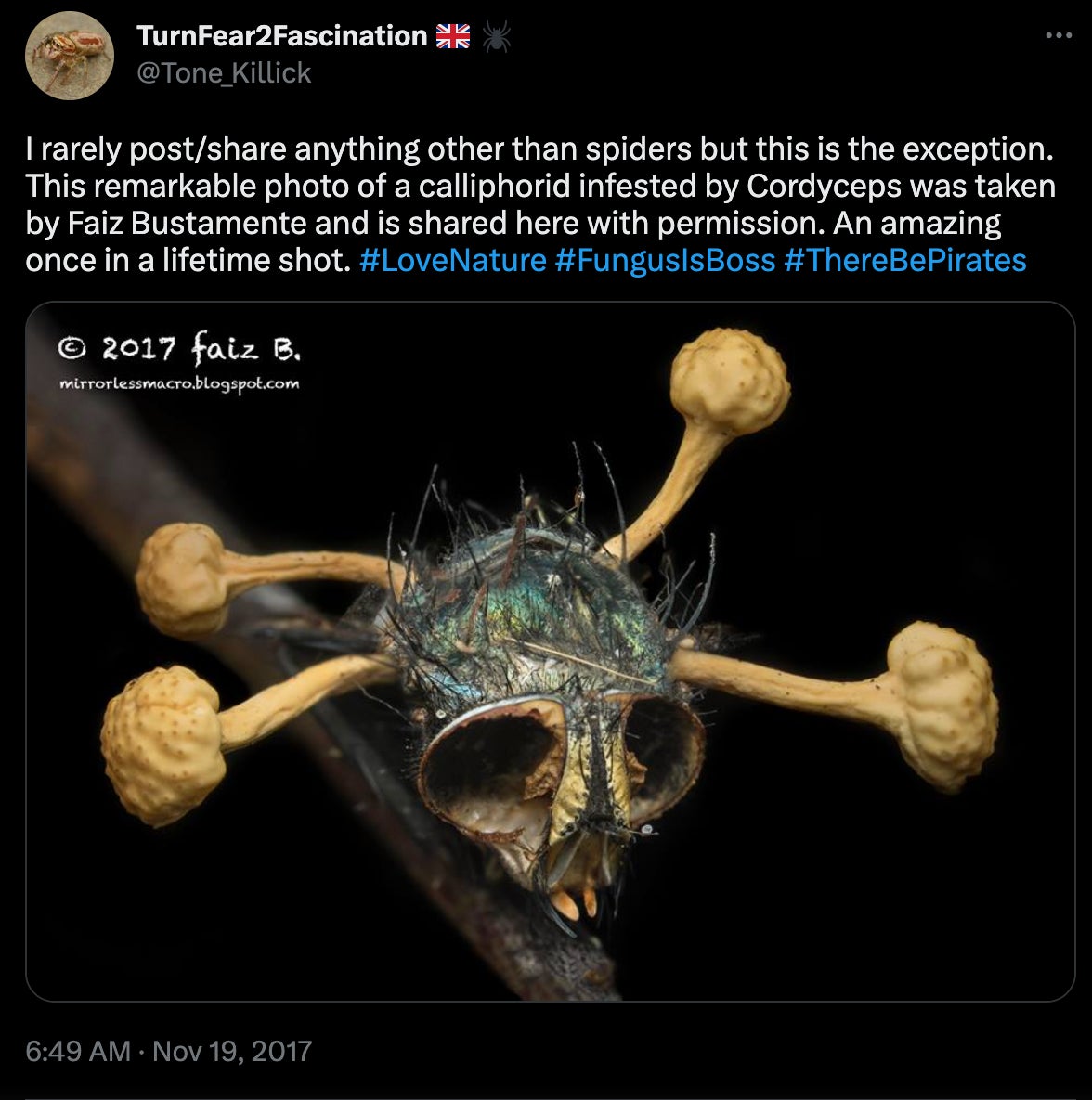🍄 Cordyceps: Nature’s own zombie-maker
Control freaks


The original version of this Obsession ran in 2017, when the words “pandemic” and “clickers” weren’t part of our everyday vernacular. Please enjoy the scarier, Pascal-ier 2023 version.
Control freaks
But make no mistake—cordyceps are both intriguing and terrifying. The word refers to a genus of fungi capable of overriding even the most basic instincts of its prey. They’re forest parasites, largely (but not entirely) found in tropical climates, infecting an insect host—usually while it’s eating—and taking over its body.
Thankfully, we’re not at a point where cordyceps are taking over human brains like in The Last of Us. But when you think about it, these little fungi are ingenious: Although evolution didn’t provide them with the means to make it on their own, they use the natural world around them. It’s kind of like how we’ve been able to exploit so much of the Earth for our benefit—except much more covert.
Let’s host some theories.
By the digits
1818: Year scientists first recognized the cordyceps genus
400+: Number of species of cordyceps found worldwide
3,800 m and above: Altitude at which Cordyceps sinensis—a caterpillar fungus used as a longevity supplement in Sikkim, India—makes its home
$100 million: Purported budget of HBO’s The Last of Us TV series, more than each of the first five seasons of Game of Thrones
37 million: Copies of the PlayStation game The Last of Us that developer Naughty Dog has sold since its release in 2013
$6,640: Cost of cyclosporine, a drug derived from cordyceps, for a patient receiving a heart transplant in 1995
$230: Cost of 60 vials (of 0.4 mL each) of generic cyclosporine today

Horrifyingly beautiful
At first glance, it looks like a cute skull and crossbones brooch. But nope! This is what’s left of a fly after cordyceps had its way with it. Read more about macro photographer Faiz Bustamente’s work here.

Celebs of the cordyceps world
There are hundreds of types of cordyceps, and most of them specialize in attacking just one species. (It’s like having a bespoke zombie fungus to call your very own!) But perhaps the pop-culture poster child of cordyceps that inspired the monsters of the video game and TV series The Last of Us and the book The Girl with All the Gifts is Ophiocordyceps unilateralis.
Here’s how Ed Yong at the Atlantic describes what they do:
“When the fungus infects a carpenter ant, it grows through the insect’s body, draining it of nutrients and hijacking its mind. Over the course of a week, it compels the ant to leave the safety of its nest and ascend a nearby plant stem. It stops the ant at a height of 25 centimeters—a zone with precisely the right temperature and humidity for the fungus to grow. It forces the ant to permanently lock its mandibles around a leaf. Eventually, it sends a long stalk through the ant’s head, growing into a bulbous capsule full of spores. And because the ant typically climbs a leaf that overhangs its colony’s foraging trails, the fungal spores rain down onto its sisters below, zombifying them in turn.”
Pop quiz
What is the high end of the death rate range for the fungus Candida auris?
Medicine from monsters
Luckily for us humans, cordyceps haven’t figured out how to take over our brains (yet). We’ve actually found medicinal uses for these creatures, which is either us winning against them... or them winning against us. We’re not sure.
The most important of these fungal medicines is cyclosporine. In 1969, Swiss microbiologist Jean-François Borel picked up a soil sample in Norway on vacation. When he brought it back to his lab, he found it contained the mold Tolypocladium inflatum—a type of fungus that produces the compound needed to selectively block the immune system of transplant recipients. It turns out Tolypocladium inflatum is the asexual form of Cordyceps subsessilis, which takes over the bodies of scarab beetles when it’s sexually reproducing. To date, this drug is arguably one of the most important advancements in transplant surgery.
Indigenous communities in Asia have been using cordyceps for years medicinally, and recent research suggests that these mushrooms may actually have an anti-inflammatory effect. That could mean it has uses in autoimmune diseases like asthma and arthritis, and perhaps even cancer. Others tout the fungi as a way to boost the elusive “masculine energy”—although the evidence for these claims is very limited.
Take me down this 🐰 hole
Photojournalist Kevin Frayer did a fascinating series published on Huffington Post on Tibetan nomads who have adopted a new business: harvesting cordyceps from caterpillars to meet the demand driven by Chinese medicine. “The locals know it’s a false economy, or at least temporary in many ways—one Tibetan man referred to the fungus as ‘fool’s gold’ and he worried that one day they will be worthless,” Frayer said.
Quotable
“Which means that right now, there’s something that’s just waiting to blow up—you just don’t know about it. It was so upsetting to say to people, ‘We knew about this, it’s been there, now we’re gonna show you the night it finally happens.’ Not suddenly, but finally.”
—Craig Mazin, the screenwriter and director behind HBO’s The Last of Us and Chernobyl, comparing the two series and how, like the nuclear disaster, fungus danger has always been real and present.
Watch this!
This video from Be Smart details some of nature’s creepiest biochemistry hacks, including “psychedelic zombie escargot.”
Listen to this, though
Some fungi want to get in our bodies, some want to clothe us. Listen to our Quartz Obsession podcast episode on mycelium—also known as “mushroom leather”—and breathe a little easier.
⬇️ Or download on: Apple Podcasts | Spotify | Google | Stitcher
👀 Prefer a transcript? The fungi allowed us to make one.
Poll

Imagine cordyceps has jumped to humans. You...
- Embark on a cross-country journey to find the cure
- Hunker down in a doomsday-prepped basement
- Plant a strawberry garden with your true love
- Oh, I’d be infected instantl...SCREEEEECH!
Tell us your answer, and best of luck to us all.
💬 Let’s talk!
In our last poll about fat-finger trades, you were pretty evenly spread across the options, but a narrow majority of you admitted to having accidentally tapped that 30% tip button.
Today’s email was written by Katherine Ellen Foley (would just hunker down with her cats), with a few updates from Morgan Haefner (would just hunker down with Pedro Pascal), and edited by Susan Howson (would just hunker down with the fungus zombies, they’re kind of pretty in their own way).
The correct answer to the pop quiz is B., 60%. Candida auris is drug-resistant, which is why a recent outbreak of the fungus has so many hospitals across the US on high alert.
